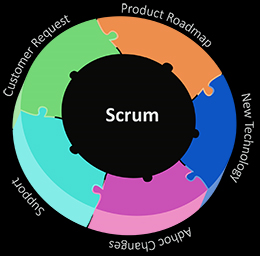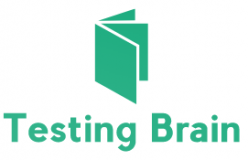Scrum is a management and controls process that cuts through complexity to focus on building software that meets business needs. They are basically small teams that focus on working in an intensive and interdependent work environment. Here you can refer the advantages, disadvantages, methodology and PDF tutorials about it. Scrum itself is a framework for effective team collaboration on complex software projects. They need real time and fast decision making process which is need for getting accurate information and on actual events. Teams in the organization work together in a team focusing on the organizational goals that they need to achieve. The team is hard working and goal oriented even though it is a small team work.
Scrum is a repetitive and incremental framework for project management majorly used in very active software development. Scrum methodology gives premium to functional software, the freedom to change along with new business realities, collaboration and communication. It is a flexible, holistic strategy of product development in which a team of developers works as a unit in order to accomplish an objective that is common to them all,
challenging assumptions of the “traditional, sequential approach” to product development.
There are three primary roles in scrum methodology and they include: Product owner, Team member and Scrum master;
- Product owners relate vision of the product to the development team and stand in customer interests through requirements and prioritization
- Scrum masters behave as a connection between the team and the product owner. Their main aim is to remove any blockade that may prevent the team from reaching its set goals. Scrum masters help the team to remain creative and productive.
- Scrum teams usually comprise seven cross-operational members. For example, software projects have analysts, software engineers, architects, programmers, UI designers, QA experts and testers.
Scrum teams also involve stakeholders and managers besides the major roles. These players don’t have any official roles in the scrum and are involved in the process only once in a while. Their roles are often known as subordinate roles.
The scrum methodology has three main artefacts which are:
- Product Backlog: This is a high-level list maintained throughout the entire project. It is used to join backlogged items.
- Sprint Backlog: This contains the list of work the team needs to carry out during the successive sprints. The features are broken down into tasks, which are normally between four and 16 hours of work.
- Burn Down: This chart shows the remaining work in the sprint backlog. It provides a simple view of progress of sprint and is updatable every day.
Scrum is a feedback-based empirical methodology which is, like all empirical process control approaches, supported by the three foundations of Inspection, Transparency and Adaptation. These three foundations require openness and trust in the team, which these five values of Scrum support
Openness
Members of the team and their stakeholders consent to be open about their work and any issues they encounter.
Commitment
Members of the team individually promise to reach their team goals, in every Sprint.
Courage
Team members know they are courageous to work through disagreement and issues together so they can do what is right.
Respect
There is respect among team members to be capable technically as well as to work with the right intent.
Focus
Members of the Team concentrate exclusively on the goals of their team and the Sprint Backlog; no work should be done outside their backlog.

ADVANTAGES OF SCRUM PROCESS IN HELPING THE ORGANIZATION
- Agile scrum helps in saving time and money.
- Due to short sprint and constant feedback, it is easier to cope with the changes.
- Iterative in nature as it requires constant feedback.
- Delivery of products at constant time. No delay in delivery.
- Overhead cost in process management is minimal leading to quicker and cheap results.
- Receives higher customer satisfaction.
WHAT ALL IS INVOLVED IN AGILE SCRUM? ( Methodology )
Scrum Master: Acts as a facilitator of the product owner and the team. The scrum master helps remove the difficulties that come across the team in achieving the organizational goals. This will help the team in being active and making sure that the work is being reported visibly to the project manager.
Prioritization of tasks: The scrum master looks after the working of the employees in the team. As the team works together, easiness and proper prioritization of the work will be delivered at the correct time. The scrum model seeks daily scrums as the way to synchronize the work of the team members as they have to discuss the work of the sprint.
Daily Scrum Meeting: All team members should attend the meeting on daily basis including the Scrum Master and the product owner. This is the meeting which has a fixed time not more than 15 minutes and it basically deals with the task that they have to do, will do and identifies any impediments to the progress.
Review of the work: The team conducts a sprint review during which the team derives the new functionality to PO or any other stakeholders that can provide reliable feedback that can improve the functionality of the sprint goals.
This feedback loops with scrum software development which may result in the changes to the freshly delivered functionality but likely to result in revising or adding items to the product backlog.
DISADVANTAGES OF SCRUM AGILE SOFTWARES
- Without a clear definition, it becomes difficult for the scrum master to plan, structure and organize a project that lacks clear definition.
- Scrum is a small team in an organization and if the team members are not active enough to work together or are not committed then there can be a loss to finishing the organizational goals and also chances for project failure.
- Sprint relentlessly follow each other in rapid succession and might lead to burn out.
- As all the teams work together to gain goals and if one or two members of the team leaves during needed times, it will totally affect the project where they have to find one with the same pace without any training as they have to go all over again which takes lot of time in finishing the work on time.
- To get the quality of work is hard if one of the team is not active toward the work and does not report the work to the Project manager on time.
- Proper framework can be done only when there are experienced team members where they can work fast and finish on time the goals.
- If daily meetings are being conducted, then there wont be anything to deliver as the work they have to plan which require lot of planning on how to work and to finish at the given time.
